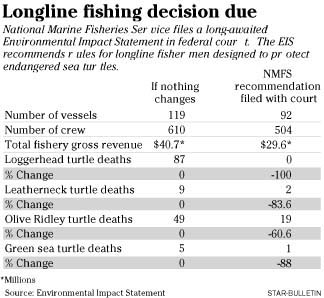


Longliners may FOR TWO WEEKS, Hawaii-based longline boats have been docked two and three deep in Honolulu because there is not enough dock space for all to be in port at the same time.
get approval to
put to sea
Judge Ezra is expected to issue
a ruling tomorrow that follows
a report's guidelinesBy Diana Leone
Star-BulletinTomorrow U.S. District Judge David Ezra will rule on their future: Where can they fish, and when and how.
Ezra said he will follow the guidelines set out in the 4-inch-thick final environmental impact statement produced by the National Marine Fisheries Service and filed Tuesday in federal court. The guidelines will require Hawaii-based longliners to:
>> Stop fishing for swordfish.
>> Stop fishing for tuna in a prescribed area south of Hawaii during April and May of each year. (Area boundaries are the equator on the south, the 180 degrees longitude on the west, the 145 degrees longitude on the east and 15 degrees latitude on the north.)
>> Be limited in fishing elsewhere during part of the year and returning to Hawaii.
>> Be required to take fisheries service workshops on turtle biology and ways to free accidentally hooked animals, and to carry appropriate gear to free the turtles on all boats.
The rules are a sharp contrast to the almost unfettered fishing that Hawaii-based longliners enjoyed until the Center for Marine Conservation and the Turtle Island Restoration Network filed a lawsuit against the National Marine Fisheries Service. The suit alleges the federal agency did not do an adequate job protecting threatened and endangered sea turtles from accidental injury and death by Hawaii's longline industry.

"I'm very happy it looks like we're going to be able to bring this to an appropriate conclusion," Ezra said this morning during a 30-minute teleconference with lawyers involved in the case. The fisheries service environmental impact statement, on which he will base his ruling, "I think does validate what the court has been doing in this case," he said.Ezra said that he has ruled on the case based on the law and that "the public, the environment and fishermen in the long run are going to be the ultimate winners."
Longliner captain Steve Gates said his boat, Miss Lisa, is ready to leave as soon as Saturday.
The Center for Marine Conservation's Mark Powell said from San Francisco last night that he is "skeptical that it's enough for the turtle."
Honolulu EarthJustice attorney Paul Achitoff said he's satisfied that the ruling will make things better for the turtles and "that the EIS (environmental impact statement) resembles closely the judge's injunction vindicates the efforts of the plaintiffs and the judge."
Longliners have argued that whatever restrictions are placed on them will have little effect on the overall population of sea turtles -- because there are so many unregulated foreign and mainland U.S. boats that fish the same waters.
But the conservationists say that protecting the turtles has to begin somewhere.
According to the environmental impact statement, if no changes are made, as many as 87 loggerhead turtles, nine leatherback turtles, 49 olive ridley turtles and five green sea turtles could be killed annually as a side effect of Hawaii-based longline fishing.
By employing the methods it proposes, the statement said, those numbers could be reduced to no loggerheads, two leatherbacks, 19 olive ridleys and one green turtle. The study admits that a number of factors could influence the actual results.
At United Fishing Agency, Oahu's commercial fish auction, fish sales normally take all morning but have been as short as 30-minutes without the catch of longliners. Manager Brooks Takenaka said this morning that he'd expect local fish supplies to increase in about two weeks after the first longline vessels go out Saturday.
"It depends on how quickly they can get into some fish, but we might see some in less than two weeks," he said.